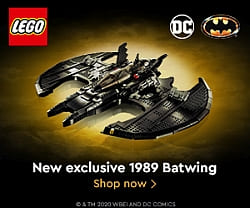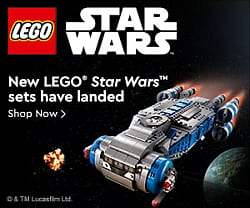(Written by Chi-bacca)
Welcome to Part 4 of the little series I’m doing where I share an experiment of giving myself a LEGO building challenge. If you haven’t read the previous posts, you can find them here: The LEGO MOC Challenge – Part 1, The LEGO MOC Challenge – Part 2 and The LEGO MOC Challenge – Part 3. This time I will share with you some of the LEGO building techniques I used in my most recent LEGO models. Hopefully they will give you ideas for your own LEGO creations! 🙂
First up is a small LEGO temple that I imagined being in the desert – therefore the use of the tan and brown color scheme. The entrance isn’t tall enough for a minifigure to walk through, but this is on purpose; in almost every adventure-film where abandoned temples are included, the characters have to crawl their way in to find the lost treasure, or whatever they are looking for.
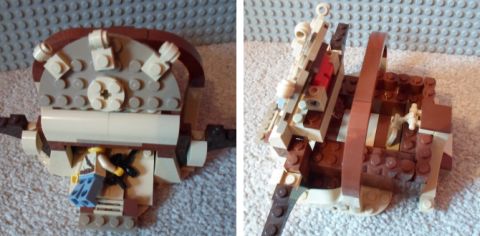
The inside of the temple is only 4 studs wide with a tile floor and an occasional jumper-plate (tiles with only one stud) – these are useful to be able to pose minifigs without breaking up the smoothness of the tile flooring. Hidden deep inside the temple is a map that is attached to a droid-arm and can move to show the map has been taken or may even be part of a trap.
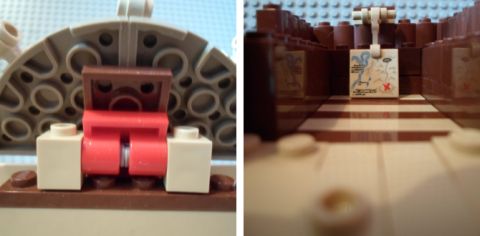
Some other LEGO techniques I used here is the angled front wall that has been achieved using a couple of LEGO Technic pins attached to a modified plate with pin-holes (the red element you see). Another fun trick I used at the front wall, and something new LEGO builders may not know about, is that the 1×1 round plate fits perfectly between 4 LEGO studs. This allows you to angle pieces any way you want, giving you more options that just building in 90 degree angles.
The second LEGO creation I would like to show you is a military snow-base. Again, choosing the right color is important, so here I used white elements to mimic a wall of snow and also create a trench effect. As you can see, I’m using several of the minifigures from the collectible series, and I also used their stands to make a walkway inside the base. Other features include a giant cannon built on a LEGO turntable so it can move any way. There is also a small shelter where explosives are kept. A funny little detail I added is the guy stuck in the snow upside down. Only the legs are used, not a whole body – a technique LEGO designers used in one of the Christmas LEGO sets. 😀
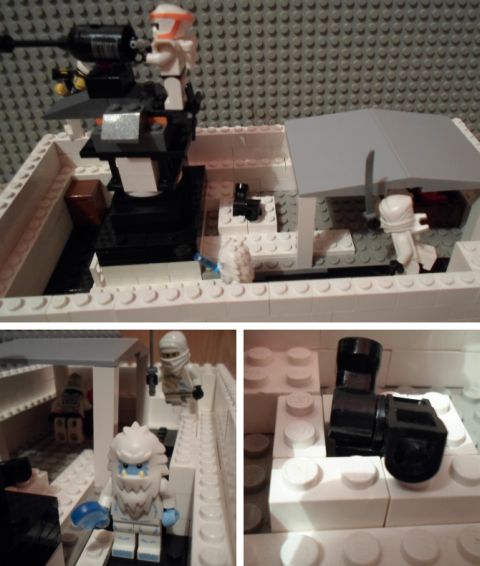
The third LEGO creation I wanted to share is a heavily armored car. This didn’t turn out exactly the way I envisioned it, but that sometimes happens when you work with LEGO; you have one idea in mind and it turns out to become something else. I was aiming for a form of deception with slightly raised tracks and wheels underneath. The wheels and the tracks are connected with LEGO Technic axles so as the wheels move, so are the treads. Not exactly how I wanted it, but I ran out of time and pieces to use.
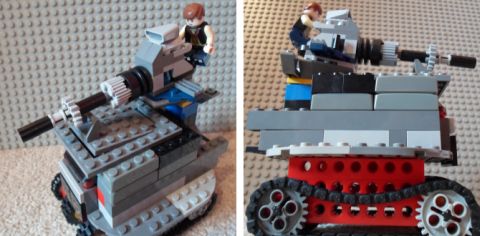
Since this is a heavily armored military vehicle I also added a large cannon. I used a LEGO engine piece as a target-locator – which is just a reminder that it is a good idea to challenge yourself to think outside the box. You can use LEGO pieces in any way you want, not just what you see in official LEGO sets. Sometimes just by turning a piece in a different angle or upside-down you realize it is perfect for an application you never thought of before. This is an especially useful technique in LEGO micro-building, where a small piece can represent an entire structure – something I hope to cover in a future post.
I hope this little narrative of some of the LEGO creations I have been working on gives you some ideas for your own LEGO models. Do you use interesting techniques when you build with LEGO? Have you discovered some on your own? Do you pay attention to color and functionality in your LEGO creations to make them more realistic? Or do you prefer more fantasy designs? Feel free to share in the comment section below! Also, I’m a TFOL (Teen-Fan-of-LEGO) and this is my sixth article here. You can check out my previous posts below. Thanks for reading! 😉










